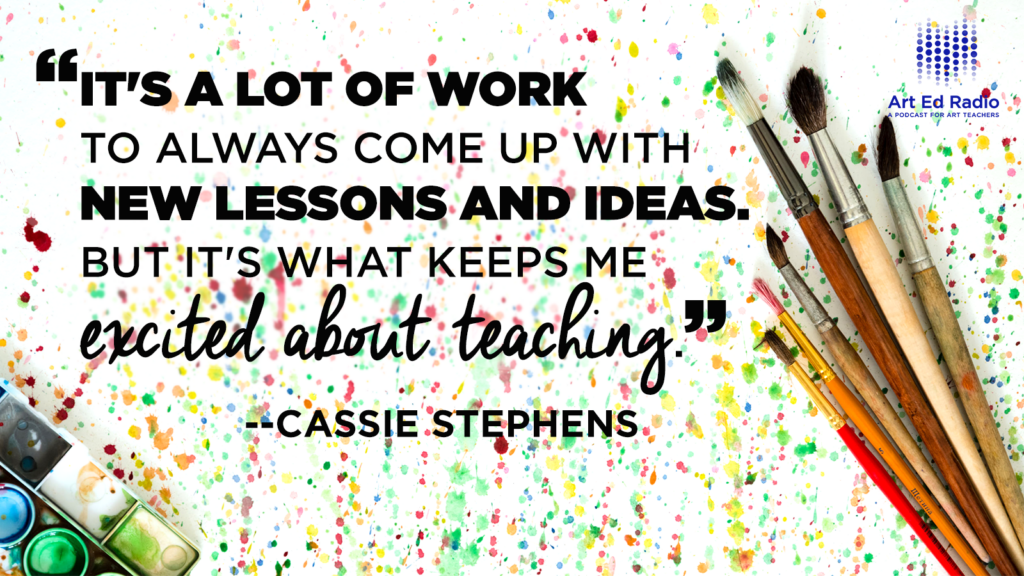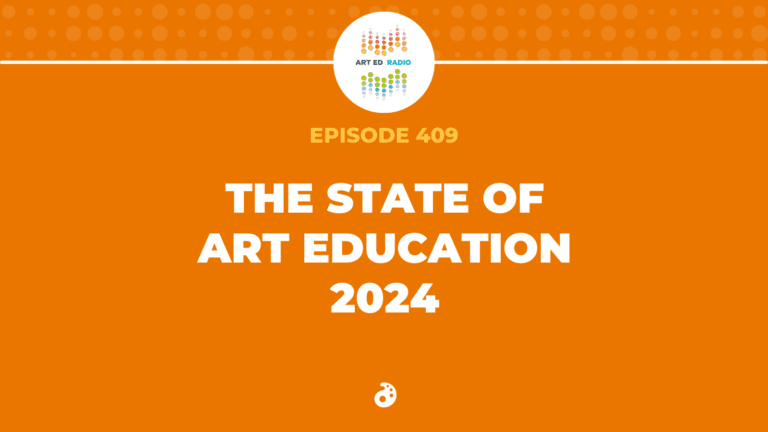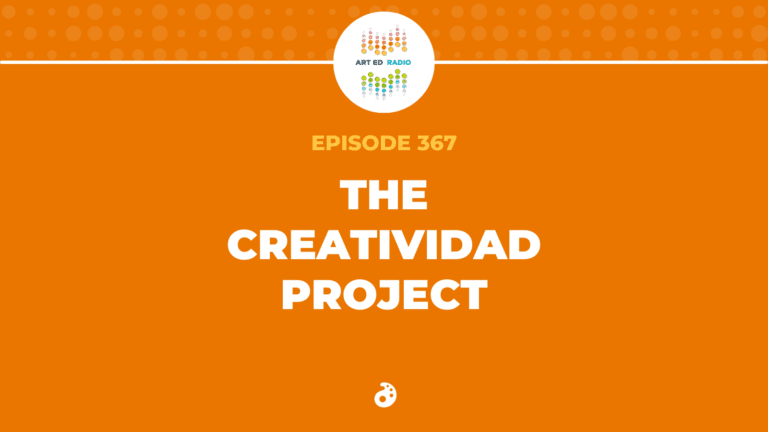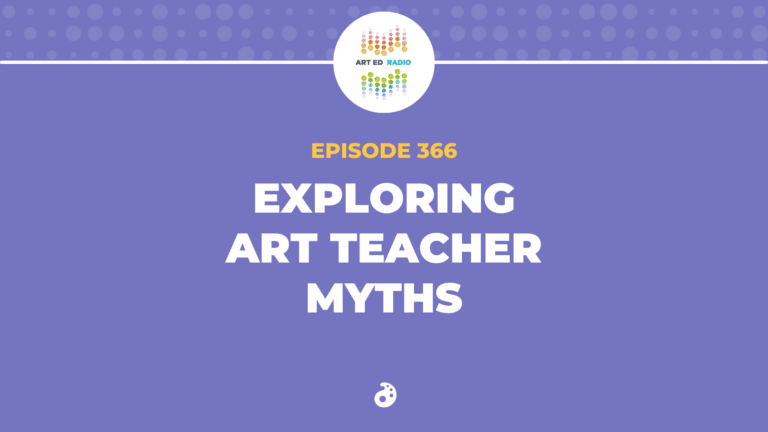Tim interviews the one and only Cassie Stephens for this episode, and they discuss some the best ideas from transitioning from summer mode back into school. They cover where inspiration comes from, and how you can bring that inspiration into your teaching. Tim starts the episode with a big announcement about AOE’s newest podcast (1:30), then Cassie shares information about her upcoming Art Ed Now Conference presentation (5:30), and the new lessons coming into her classroom this year (11:45). They then close the conversation with a rundown of the upcoming Everyday Art Room podcast, and why Cassie wanted to host the show (18:45). Full episode transcript below.
Resources and Links:
- Take a look at Cassie’s blog and all of her incredible resources
- The Clay Lab for Kids book
- An interview with Cassie, and a great lesson
- Check out all of Cassie’s AOE videos

Transcript
Welcome to Art Ed Radio, the podcast for art teachers. This show is produced by The Art of Education, and I’m your host, Tim Bogatz.
I’ve got some exciting news and an exciting guest today. The one and only Cassie Stephens is going to join me in just a little bit to talk about the best ways to transfer out of summer mode and get into back-to-school mode. We’ll also talk about how and why we should be exploring new ideas every year. I think it’s going to be a really good conversation.
I also want to remind you about the Art Ed Now Conference coming up in just two short days. Cassie will be there, along with 20 other amazing presenters. If you are listening to this podcast on the day it comes out, there is still time. It is the last day to sign up. Sir Ken Robinson is the featured presenter, and there is so much there for you to learn from. Like I said, awesome presentations and new ideas that are the latest and the best in art education. You can check it out at artednow.com. If you miss the deadline or miss the conference, please make sure you sign up for the next one. The 2018 Art Ed Now Winter Conference will be taking place on February 3, 2018. I am already working on lining up presenters, and, trust me, it will be worth your while.
As much as I want to talk about upcoming conferences, because I get really excited about everything that’s going on, I promise that I have some big news for you, and it’s related to our guest today. I am thrilled to announce that The Art of Education is releasing a second weekly podcast, called Everyday Art Room, that will be hosted by Cassie Stephens. It will be an entertaining, engaging look at the world of elementary art teaching. The first episode will be coming on Thursday, August 10th, and each Thursday a new episode will debut.
I will talk to Cassie today about the podcast and the direction she is taking it, but I want to tell you what I’m excited about. First, she has some incredible stories, incredible advice, and a lot of experience that she’s ready to share. Secondly, I know we need an elementary voice with our podcasts. As much as Andrew and I try to talk about teaching at every level, I know that our own experiences and our conversations skew toward the secondary side. Finally, I love that Everyday Art Room will be relatable. Andrew and I talk a lot about philosophies and theories and sometimes get into the weeds on some really different ideas, but Cassie will talk a lot more about the day-to-day, week-to-week process of running an art room and being the best teacher you can be. If I were to wrap that up, in short, I think that Everyday Art Room will be the perfect complement to Art Ed Radio, and I want you to make sure that you check it out next Thursday.
But it is time to talk to Cassie about, like I said, moving from summer back to school, why we should explore new ideas, how we improve as teachers, and, finally, a little bit about the new podcast. Let me bring her on right now.
I am here with Cassie Stephens. Cassie, thank you for joining me. How are you?
Cassie: I am fabulous. It’s a beautiful 99-degree morning in Tennesse, so that’s just the way our summer goes. But you know what? It’s summer vacation, so you can’t ask for anything better than that.
Tim: Yeah. It’s the same way in Nebraska right now. I believe 102 is forecast for today. It’s a little toasty. Hey, I wanted to ask you, I wanted to start out with, we are just a couple days away from the Art Ed Now Conference, and I’m super excited that you are presenting again. You’re going to be talking about air-dry clay and all of the amazing lessons that you can do without a kiln, which is also backed up by the book you wrote. I guess, can you talk a little bit about what your conference presentation is going to be about and everything you went through with your book and whether you still love all of these clay options or whether you’re getting sick of them at this point with all the work you’ve done?
Cassie: Sure. Actually, June 30th marked the one-year anniversary when I finally wrapped up the book. From June 30th it took about six months before the book was actually in my hands, and prior to that it was another about six to nine months of just writing the book. When you ask me if I’m still excited about clay or the projects I shared, I’m going to have to be real honest and say I was pretty over the whole clay experience. The book entails 52 clay projects, which is like writing 52 lesson plans, but also documenting each step of the way. It was a tall order. I am thrilled that I did it, thrilled that I’m done with it. What it did for me was it gave me a ton of experience of working with a variety of clay.
The book is divided into three parts, and the first half is air-dry clays. I have tested out every air-dry clay on the market. Each one has its own positive and negative qualities. I definitely have favorites, ones that I think would be great in a classroom, especially an elementary classroom to give students that experience, if you’re an art teacher without a kiln. If you’re a teacher with a kiln, I don’t see any reason why you wouldn’t use kiln fire clay, why you would resort to air-dry, unless just maybe the labor of firing your kiln is a lot of work. That being said, though, the projects in the book can be done with both kiln fire and air-dry clay.
The middle of the book is polymer clay, which is Sculpey, as we know, which is hardened by baking in the oven. Then the last half of the book, which was pretty funny to me, are recipes for creating your own clay. I am not a cook or a baker by any means, so the fact that I had to come up with recipes was quite funny to me. But all that to say these projects are definitely ones where I’ve tested them out with my own students. We had a lot of success. I’m still excited by a lot of the ideas and projects in the book, and I would for sure continue to bring them to my students in my art room.
Tim: Nice. I like that. You’re going to be sharing a lot of these, a lot of your favorites at the conference, right?
Cassie: Correct. I managed to pack into that short little presentation — and I say “short” in quotes because I think I went over my allotted amount of time — I am going to be sharing all of the supplies that I use when my students work with both air-dry and kiln fire clay, my favorite go-to supplies that we use. I’m also sharing I think almost half-a-dozen projects in that presentation, so get ready. You’ll have a lot of ideas to immediately take back to your art room.
Tim: Yeah, it’s a fast-paced one, and there are a lot of great ideas there so I think people are going to be excited. With the conference always comes the back-to-school feeling. For a lot of people, they are excited. Some people are dreading it. I know that you are always excited to get back, always ready to get working with your kids again. How do you stay excited about coming back to school year after year?
Cassie: Well, when you say I’m always excited and always ready, that might be a slight exaggeration. I’m just kidding. It’s so funny, because the Art Ed Now Conference actually falls on my very first day back to school.
Tim: Oh, my.
Cassie: It’s fine. Those first couple days of school, you know what it’s like. We are sitting in a delightful meeting, preferably at the back of the room where we can hang out with our other special area buddies.
How do I stay excited? Well, this is usually my summertime routine. As soon as summer vacation hits, and I mean usually the day of, my husband and I take a vacation. We are literally going somewhere the minute I leave the school building, which is great. We usually spend about a week going somewhere fun like Florida, or just even taking a road trip. What that does is it immediately immerses me in that relaxed, get-away-from-school, let-it-all-go mindset, which is perfect, because the weeks prior to that is our school-wide art show, which is a huge undertaking and it’s very stressful for me because there’s so much that goes into our art show.
Taking that vacation and getting away from all things Art Teacherin’ is a fabulous way for me to really relax. Why I think that that is so important is because oftentimes when I’m trying to think of lesson plans or dream up exciting projects for my students, I’m sitting at a table staring at a blank sheet of paper, and when you’re staring at a blank sheet of paper, you usually draw a blank. But I have found that when I’m on vacation, if I’m removed from school and removed from that mindset, I have the best ideas. I get the most inspiration from that.
I find that that for me is the most exciting way to break away from school and yet still come up with great ideas to take back to my classroom. My mom and I traveled to Italy this summer, which was a great way for me to turn off my Art Teacherin’ brain but still, I mean, I’m in Italy, so I’m surrounded by art. A lot of ideas came to me organically that I was really excited about bringing back to my art room this year.
Another thing I love to do to get excited, I usually allow myself to have my brain turned off until the end of June. When July hits, then I start to switch back to back-to-school mode, sketching out ideas, getting excited about projects, planning what kind of crazy outfit I’m going to wear to teach these projects, and also reading. I love catching up on all of the books that I’ve purchased throughout the year, all those Art Teacherin’ books or ed books, or even DIY books. I love digging deep into those so that I can start to think about how I can bring those ideas, concepts, and projects to my art room in the upcoming school year.
Tim: Yeah. I don’t know. I love that mindset and I love some of those ideas and how you approach that. I think that’s some really good advice. Let me ask you, though, if we can dive into that a little bit, what kinds of ideas are you bringing back to your classroom this year? What’s new and what’s going to be exciting for you that you’re bringing back this year?
Cassie: One thing I’d like to do at the end of every year is stop and think, without being too hard on myself, stop and think about where I went wrong with my life. That list is really wrong, by the way. I like to stop and think about: What didn’t go well? What do I need to work better at as an art teacher? Where did I maybe drop the ball with my students? Because there’s always things that we can improve upon, which is what I love about teaching, is that every school year we get the opportunity to hit the reset button and try it all over again and give new thoughts and new ideas a go.
One thing, one of the many things I feel like were my shortcomings last year was I got pretty comfortable with my students and my students in my art room. I assumed, having been there for nearly 15 years, that we all knew the routines and we all knew the rules, and let’s just dive right in and start creating. Well, what that did was is that it set up an atmosphere of us just creating and just throwing those routines out the window, and it was a little bit of a struggle, the beginning of the year, until I reined it back in and was like, “Okay, let’s do a re-do. We do have to cover some rules.”
Tim: Yeah.
Cassie: That’s something I know I’m going to need to focus on. It’s hard for me to do that because I’m always so excited about having the kids create, but I’m going to have to take it slow. That’s another thing I’m going to work on this year, is just taking it slow. Maybe dialing back on the coffee intake would help with this. I get so excited with all of these ideas and new things that we can do in the room that I feel like I’m constantly throwing something new at my students.
In fact, last year one of my fourth grade students said, “We can’t start this new project because we have three other projects we have not finished yet.” When they’re calling you out on it, you know you’re in trouble.
Tim: Yeah.
Cassie: That’s definitely something: slowing down, letting them enjoy their learning process, as well as me watching them enjoy that process. It’s hard for us as teachers, as art teachers, because we’re teaching the same project to several classes, and so for us it feels really repetitive and we just want to speed it up. But for them, we have to remember it’s their first time hearing this lesson, hearing about these artists, working with these materials, so we need to take it a little bit slower.
Also, a book that I’ve been reading and loving is The Growth Mindset Coach.
Tim: Yes.
Cassie: I definitely want to bring the concepts of growth mindsets to my art room. I think that it can make a world of a difference in a setting like an art room. If you’re not familiar, growth mindsets are the opposite of a fixed mindset. A growth mindset is one where you believe that you can grow, learn, and take things away from your mistakes, and that with hard work you can achieve your goal. Fixed mindset is the complete opposite of that, where you take any sort of defeat and you use that to define you. I really think that that can be empowering to my students for them to realize that we are continuously learning and growing even into adulthood, which I want to share that with my students.
Then, one last thing that I really would like to share with my kids this year, or bring back to my art room, is more drawing and more sketching lessons and projects. I feel like because I get so excited about having them roll their sleeves up and get messy and creating with clay and painting, I have a tendency to skip over drawing. I know you and Andrew did a great podcast about all those lessons you can throw out the window, and I think that that is my fixed mindset. My fixed mindset was, “Well, drawing is just perspective drawing, and that’s boring. I don’t want to do that with my students.” But drawing can be so much more, and I as an art teacher need to remember that when I bring that to my students.
Those are some things that I want to work on this coming school year.
Tim: Yeah. I like a lot of those ideas. If I can ask you just something related to the growth mindset. I love that idea for students, but I also love that idea for teachers. I very much respect how you are constantly evolving, constantly coming up with new ideas. Let me ask you, how important is it to you to change what you’re doing each year and always try and bring in these new ideas to your students?
Cassie: Well, it’s important to me because it keeps me excited about teaching. I’m always surprised and a little bit in awe of those teachers, and I’ve met art teachers like this as well, where they have organized bins of, “This is what I’m going to teach the first week of school. This is what August is going to look like. I know exactly what lessons I’m going to teach and what projects I’m going to do.” I have a lot of respect for those kind of teachers because they are so stinking organized, but that’s just not how I am as a teacher. For a long time, I think that I tried to fit my square peg into a round hole kind of thing, trying to force myself to be the art teacher that I thought I should be or the ones that I felt like were very successful, very organized. But that’s just not me.
I think that figuring out who you are and being completely okay with that is something great and freeing that you can do as an art teacher, but being okay with that doesn’t mean being lazy with that. It means you’re still okay with it, but wanting to push yourself to be even better. Knowing that I’m not that kind of art teacher, I get excited by coming up with brand-new projects and lessons every year. It’s overwhelming, it’s probably really dumb because it’s so much work, but it’s what really gets me juiced, jazzed, and excited about coming into school every morning, that I’ve got this fun project that I know the kids are going to absolutely love.
I don’t know if that answered your question.
Tim: No, it absolutely answers the question, because it gives us a little bit of a view into your mindset and why you think that’s important. Andrew and I both are big into coming up with new things constantly, because it keeps things fresh. It keeps you from getting burnt out. I think you and I are on the same page with that.
We do need to get to the most important part of the interview. I already let everybody know in the introduction about the exciting news of the Everyday Art Room Podcast that you are going to be hosting, but I want to let everybody hear from you a little bit. Can you talk a little bit about why you want to share your ideas, why you want to do a podcast, and maybe a little bit about just what the show is all about?
Cassie: When AOE approached me with this idea, I was flattered and honored and thrilled. I love Art Ed Radio, I think you guys do a fabulous job, so I knew that I had big elementary podcast Teacherin’ shoes to fill. That was a tall order, a little bit intimidating, but I’m really, really excited about the podcast.
Here’s I think my main reason why. I, like many art teachers I’m sure, have vivid memories of my very first days and very first year of teaching art. I just remember, now this is almost 20 years ago, in a little portable trailer, just questioning myself the whole step of the way. I literally had daydreams about quitting teaching art — I was talking about this last night with a friend — and going to work at Target, because I thought it would be so less stress. “Am I doing this right? Am I doing a disservice? Am I messing these children up for life? Probably.”
All that to say is, knowing that lonely feeling, when I approach the podcast I like to think of it as me talking to those first-year teachers who luckily have blogs and podcasts and the internet to turn to, but I know it’s still very, very lonely. I like to in my podcast reach out to those teachers who might feel like they’re on a lonely island and offer a little bit of help, advice if I can, and just for them to know you’re not alone. We are all in this together. None of us know exactly what we’re doing, which is the beauty of it, because we can all continue to grow the way that we are meant to grow. I think that if that podcast can help just a few people, it’ll make a big difference for me and remembering those memories in the trailer in Nashville.
Tim: I think that’s a really good reason as far as why you would want to put together this podcast, share your ideas. I think people will be excited to hear all of that. Can you talk just a little bit about maybe the first few episodes, ideas that you want to share, and let people in on some of the specifics of what you’re going to be talking about?
Cassie: Of course. The podcast is geared toward elementary art teachers. I feel like at the beginning of every school year, no matter how long you’ve been teaching, you want to set the tone that’s going to establish your art room for the entire year. Those first handful of podcasts are all about how to set an awesome tone that’ll really establish a great school year. The first one, I’m going to chat about my eight top routines that I establish with my students that we use all year long. Then I follow it with my favorite three rules. We only have three rules in my art room. Then followed of course by consequences, because they always … Not all rules are followed. There is no ideal art room where all rules are followed. There has to be consequences when rules are broken.
Basically, the first handful of podcasts are just digging deep into what you need those first couple of days and weeks to have a great and successful school year. From there, I thought I would share more about the projects that I do in my art room, the nitty-gritty of what kind of painting supplies, how to set up your art room for a successful painting unit or clay unit, really digging deep into all those things elementary art room so that teachers feel really excited and a little bit more prepared when they approach teaching their own art kids.
Tim: Yeah. I think that’s really, really cool, and I think that gives everybody something to look forward to. There’s going to be a lot of excitement about this podcast. Like I said, we’re all looking forward to it. I think it’s time for us to wrap it up. Cassie, thank you so much for joining me and sharing a little bit about what’s coming up. We’ll hopefully talk to you again soon.
Cassie: Awesome. Thanks so much for having me, Tim.
Tim: That will do it for this episode of Art Ed Radio. I hope to see you at the Conference on Thursday. Not only will Cassie be presenting, you might even catch sight of me hosting for just a little bit. There is a lot of great stuff planned: hands-on art making, creativity and choice, inspiration, and ways to make your teaching memorable.
Even if you’re not there for the spectacular day of professional development, I hope that you can still find what you need for PD here at the Art of Ed. Whether it’s this podcast or some articles or an Art Ed PRO subscription, we want you to find what you need to help you become the best art teacher you can be. I hope that this podcast and the Conference, the new podcast, are all steps that you can take on that journey of continual improvement, the one that every art teacher should be on.
Art Ed Radio is produced by The Art of Education, with audio engineering from Michael Crocker. Remember that you can sign up for our email list at artedradio.com. Keep an eye out for Cassie’s podcast coming soon. We’ll let you know how and where to subscribe. Until then, keep listening to Art Ed Radio. We’ll be back next week when Andrew and I talk about classroom management and how we start at the beginning of the year. Thanks for listening.
Magazine articles and podcasts are opinions of professional education contributors and do not necessarily represent the position of the Art of Education University (AOEU) or its academic offerings. Contributors use terms in the way they are most often talked about in the scope of their educational experiences.



